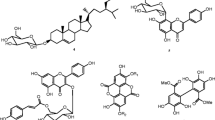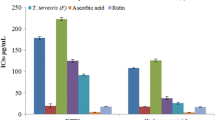Abstract
The petroleum ether, chloroformic, ethyl acetate, methanolic, Total Oligomers Flavonoids (TOF) enriched extracts, water extract as well as its fractions A1, A2, A3 obtained from aerial parts ofRhamnus alaternus, a Tunisian-Mediterranean medicinal species, were investigated for the contents of phenolic compounds, cytotoxic activity against the K562 human chronic myelogenous leukaemia cell line and L1210 leukaemia murine cells and for antibacterial activity against Gram positive and Gram negative bacterial reference strains. A pronounced cytotoxic effect on both the cell lines was shown in the TOF, ethyl acetate, methanolic, aqueous extracts and A2 fraction, with respectively IC50 values 75, 232, 298, 606 and 571 μg/ml on K562 cells and 198, 176, 767, 560 and 614 μg/ml on L1210 cell line. Significant activity against bacterial reference strains:Staphylococcus aureus, Enterococcus faecalis, Escherichia coli, Salmonella enteritidis andSalmonella typhimurium was shown with ethyl acetate, TOF extracts and A2 fraction. The antimicrobial and cytotoxic activities showed byR. alatemus depended on the chemical composition of the tested extracts.
Similar content being viewed by others
References
Abdelwahed A., Bouhlel I., Skandrani I., Valenti K., Kadri M., Guiraud P., Steiman R., Mariotte A.M., Ghedira K., Laporte F., Dijoux-Franca M.G., Chekir-Ghedira L. (2007). Study of antimutagenic and antioxidant activities of gallic acid and 1,2,3,4,6-pentagalloylglucose fromPistacia lentiscus, Confirmation by microarray expression profiling. Chem. Biol. Inter., 165: 1–13.
Abou-Chaar Ch.I., Kabbara R.A., Shamlian N.S. (1982). A chromatographic study of the anthraquinones ofRhamnus alaternus L. Extraction, isolation and chromatographic characterization of the anthraglycosides of the stern bark. Int. J. Crude Drug. Res., 20 (1): 13–18.
Ahn Y.J., Park S.J., Lee, S.G., Shin S.C., Choi D.H. (2000). Cordycepin: selective growth inhibitor derived from liquid culture ofCordyceps militaris againstClostridium spp. J. Agric. Food Chem., 48: 2744–2748.
Al-Dabbas M.M., Suganuma T., Kitahara K., Hou D.-X., Fujii M. (2006). Cytotoxic, antioxidant and antibacterial activities ofVarthemia iphionoides Boiss. extracts. J. Ethnopharmacol., 108: 287–293.
Becx M.C.J.M., Janssen A.J.H.M., Claaener H.A.L., de Koning R.W. (1990). Metronidazole-resistantHelicobacter pylori. Lancet, 335: 539–540.
Bellakhdar J. Ed. (1999). La Pharmacopée Marocaine Traditionnelle. Ibis Press, Paris.
Ben Ammar R., Kilani S., Abdelwahed A., Hayder N., Mahmoud A., Chibani J., Chekir-Ghedira L., Ghedira K. (2005).In vitro mutagenicity, antimutagenicity and free radical scavenging activities ofRhamnus alaternus L. (Rhamnaceae) extracts. Pak. J. Biol. Sci., 8 (3): 439–445.
Ben Mansour H., Boubaker J., Bouhlel I., Mahmoud A., Bernillon S., Ben Chibani J., Ghedira K., Chekir-Ghedira L. (2007). Antigenotoxic activities of crude extracts fromAcacia salicina leaves. Env. Mol. Mutagen., 48: 1–9.
Ben Mrabet K., Abed L. (1986). Quelques aspects de la pharmacopée traditionnelle algérienne. Pharmacien du Maghreb, spécial 2: 18–282.
Benavente-Garcia O., Casillo O., Marin F., Ortuno A., Del-Rio J. (1997). Uses and properties ofCitrus flavonoids. J. Agric. Food Chem., 45: 4505–4515.
Bouhlel I., Ben Mansour H., Limem I., Ben Sghaier M., Mahmoud A., Ben Chibani J., Ghedira K., Chekir-Ghedira L. (2007). Screening of antimutagenicity via antioxidant activity in different extracts from the leaves ofAcacia salicina from the center of Tunisia. Environ. Toxicol. Pharmacol., 23: 56–63.
Boukef K. (2001).Rhamnus alaternus. Essaydali, 81: 34–35.
Capecka E., Mareczek A., Leja M. (2005). Antioxidant activity of fresh and dry herbs of some Lamiaceae species. Food Chem., 93: 223–226.
Chevolleau S., Debal A., Ucciani E. (1992). Détermination de l’activité antioxydante d’extraits végétaux. Rev. Fr. Corps Gras, 39 (1/2): 3–8.
Chiang L.C., Chiang W., Liu M.C., Lin C.C. (2003).In vitro antiviral activities ofCaesalpinia pulcherrima and its related flavonoids. J. Antimicrob. Chemother., 52: 194–198.
Conner D.E. (1993). Naturally occurring compounds. In: Davidson P., Branen A.L., Eds, Antimicrobials in Foods, Marcel Dekker Inc., New York, pp. 441–468.
Cragg G.M., Boyd M.R., Cardellina II J.H., Newman D.J., Snader K.M., McCloud T.G. (1994). Ethanobotany and drug discover: the experience of US National Cancer Institute. Ethanobotany and Search for New Drugs, Ciba Foundation Symposium 185. Wiley, Chichester, pp. 178–196.
Cremieux A. (1991). Perspectives méthodologiques dans l’évaluation de l’activité antibactérienne des huiles essentielles. In: Phytothérapie, Aromathérapie, Encycl. Med. Nat., Paris, C-4.
Dhidah M., Trabelsi A., Mzoughi R., Dhidah L., Boujaafar N., Jeddi M. (1995).Salmonella and salmonelloses in the region of Sousse (Tunisia). Microbiol. Hyg. Alim., 7 (19): 3–7.
Dorman H.J.D., Deans S.G. (2000). Antimicrobial agents from plants: antibacterial activity of plant volatile oils. J. Appl. Microbiol., 88: 308–316.
Duh P.-D., Yen G.C. (1997). Antioxidative activity of three water extracts. Food Chem., 60: 639–645.
Eberhardt M.V., Lee C.Y., Liu R.H. (2000). Antioxidant activity of fresh apples. Nature, 405: 903–904.
Efthimiadou E.K., Thomadaki H., Sanakis Y., Raptopoulou C.P., Katsaros N., Scorilas A., Karaliota A., Psomas G. (2007). Structure and biological properties of the copper (II) complex with the quinolone antibacterial drug N-propyl-norfloxacin and 2,2′-bipyridine. J. Inorg. Biochem., 101 (1): 64–73.
Eloff J.N. (1998). A sensitive and quick microplate method to determine the minimal inhibitory concentration of plant extracts for bacteria. Planta Med., 64: 711–713.
Hayder N., Ben Ammar R., Abdelwahed A., Kilani S., Mahmoud A., Ben Chibani J., Mariotte A.M., Ghedira K., Dijoux-Franca M.G., Chekir-Ghedira L. (2005). Antibacterial and antimutagenic activity of extracts and essential oil from (Tunisian)Pistacia lentiscus. Toxicol. Env. Chem., 87 (1–4): 567–573.
Hirano T., Gotoh M., Oka K. (1994). Natural flavonoids and lignans are potent cytostatic agents against human leukemic HL-60 cells. Life Sci., 55: 1061–1069.
Ismail N.H., Ali A.M., Aimi N., Kitajima M., Takayama H., Lajis N.H. (1997). Anthraquinones fromMorinda elliptica. Phytochemistry, 45 (8): 1723–1725.
Izhaki I., Tsahar E., Paluy I., Friedman J. (2002). Within population variation and interrelationships between morphology, nutritional content and secondary compounds ofRhamnus alaternus fruits. New Phytol., 156: 217–223.
Jemal A., Murray T., Samuels A., Ghafoor A., Ward E., Thun M. (2003). Cancer statistics, CA Cancer J. Clin., 53: 5–26.
Kim M.S., Lee J., Lee K.M., Yang S.H., Choi S., Chung S.Y., Kim T.Y., Jeong W.H., Park R. (2003). Involvement of hydrogen peroxide in mistletoe lectin-II-induced apoptosis of myeloleukemic U937 cells. J. Life Sci., 73: 1231–1243.
Kumar A., Chattopadhyay S. (2007). DNA damage protecting activity and antioxidant_potential of pudina extract. Food Chem., 100: 1377–1384.
Kuntz S., Wenzel U., Daniel H. (1999). Comparative analysis of the effects of flavonoids on proliferation, cytotoxicity, and apoptosis in human colon cancer cell lines. Eur. J. Nutr., 38 (3): 133–142.
Larocca L.M., Piantelli M., Leone G., Sica S., Teofili L., Benedetti-Panici P. Scambia G., Mancuso S., Capelli A., Ranelletti F. (1990). Type II oestrogen binding sites in acute lymphoid and myeloid leukemias: growth inhibitory effect of oestrogen and flavonoids. Br. J. Haematol., 75: 489–495.
Lee R.M., Hirano K.I., Anant S., Baunoch D., Davidson N.O. (1998). An alternatively spliced form of apobec-1 messenger RNA is over expressed in human colon cancer. Gastroenterology, 115 (5): 1096–1103.
Luximon-Ramma A., Bahorun T., Soobrattee M.A., Aruoma O. (2002). Antioxidant activities of phenolic, proanthocyanidin, and flavonoid components in extract ofCassia fistula. J. Agric. Food Chem., 50 (18): 5042–5047.
Marzouk M.S., El-Toumy S.A.A., Merfort I., Nawwar M.A.M. (1999). Polyphenolic metabolites, ofRhamnus disperma. Phytochemistry, 52 (5): 943–946.
Matsumoto S., Washizuka Y., Matsumoto Y., Tawara S., Ikeda F., Yokota Y., Karita M. (1997). Appearance of a metronidazole-resistantHelicobacter pylori strain in an infected-ICR-mouse model and difference in eradication of metronidazole-resistant and- sensitive strains. Antimicrob. Ag. Chemother., 41: 2602–2605.
Mead P.S., Slutsker L., Dietz V., McCaig L.F., Bresee J.S., Shapiro C., Griffin P.M., Tauxe R.V. (1999). Food-related illness and death in the United States. Emerg. Inf. Dis., 5: 607–625.
Musonda C.A., Chipman J.K. (1998). Quercetin inhibits hydrogen peroxide (H2O2)-induced NF-kappa B DNA binding activity and DNA damage in HepG2 cells. Carcinogenesis, 19: 1583–1589.
Nwabueze T.U. (2007). Effect of process variables on trypsin inhibitor activity (TIA), phytic acid and tannin content of extruded African bread fruit-corn-soy mixtures: A response surface analysis, LWT-Food Sci. Technol., 40: 21–29.
O’Brien S.J., de Valk H. (2003).Salmonella — “old” organism, continued challenges! Eurosurveillance, 8: 29–31.
Park B.S., Lee H.K., Lee S.E., Piao X.L., Takeoka G.R., Wong R.Y., Ahna Y.J., Kima J.H. (2006). Antibacterial activity ofTabebuia impetiginosa Martius ex DC (Taheebo) againstHelicobacter pylori. J. Ethnopharmacol., 105: 255–262.
Pearson D. (1976). The Chemical Analysis of Foods, 7th edn. Churchill Livingstone, London.
Polydoro M., De Souza K.C.B., Andrades M.E., Da Silva E.G., Bonatto F., Heydrich J., Dal-Pizzol F., Schapoval E.E.S., Bassani V.L., Moreira J.C.F. (2004). Antioxidant, a pro-oxidant and cytotoxic effects ofAchyrocline satureioides extracts. Life Sci., 74: 2815–2826.
Pottier-Alapetite G. (1978). Flore de la Tunisie, Imprimerie Officielle de la République Tunisienne, pp. 138–141.
Rodriguez Vaquero M.J., Alberto M.R., Manca de Nadra M.C. (2007). Antibacterial effect of phenolic compounds from different wines. Food Control, 18 (2): 93–101.
Rosell G. (1980). Aspectos farmacognósticos y farmacodinámicos deRhamnus alaternus ssp.myrtifolia Will. II, Cir. Farm., 38 (269): 445–458.
Roussis V., Tsoukatou M., Chinou I., Ortiz A. (1998). Composition and antibacterial activity of the essential oils ofHelichrysum rupestre andHelichrysum ambiguum growing in the Balnearic islands. Planta Med., 64: 675–676.
Sakanaka S., Juneja L.R., Taniguchi M. (2000). Antimicrobial effects of green tea polyphenols on thermophilic spore-forming bacteria. J. Biosci. Bioeng., 90 (1): 81–85.
Todd E.C.D. (1989). Costs of acute bacterial foodborne disease in Canada and the United States. Int. J. Food Microbiol., 9 (4): 313–326.
Tona L., Cimanga R.K., Mesia K., Musuamba C.T., De Bruyne T., Apers S., Hernans N., Von Miert S., Pieters L., Totté J., Vlietinck A.J. (2004).In vitro antiplasmodial activity of extracts and fractions from seven medicinal plants used in Democratic Republic of Congo. J. Ethnopharmacol., 93: 27–32.
Tona L., Kambu K., Ngimbi N., Cimanga K., Vlietnick A.J. (1998). Antiamoebic and phytochemical screening of some Congolese medicinal plants. J. Ethnopharmacol., 61: 57–65.
Uliasz T.F., Hewett S.J. (2000). A microtiter trypan blue absorbance assay for the quantitative determination of excytotoxic neuronal injury in cell culture, J. Neurosc. Meth., 100: 157–163.
Wink M. (1993). Production and application of phytochemicals from an agricultural perspective. In: van Beek T.A., Breteler H., Eds., Phytochemistry and Agriculture, Proc. Phytochem. Soc. Europe, Vol. 34, Clarendon, Oxford University, Press, pp. 171–213.
Yuan V.Y., Bone D.E., Carrington F. (2005). Antioxidant activity of dulse (Palmaria palmata) extract evaluatedin vitro. Food Chem., 91 (3): 485–494.
Zhishen J., Mengcheng T., Jianming W. (1999). The determination of flavonoid contents in mulberry and their scavenging effects on superoxide radicals. Food Chem., 64 (4): 555–559.
Author information
Authors and Affiliations
Corresponding author
Rights and permissions
About this article
Cite this article
Ben Ammar, R., Kilani, S., Bouhlel, I. et al. Antibacterial and cytotoxic activities of extracts from (Tunisian)Rhamnus alaternus (Rhamnaceae). Ann. Microbiol. 57, 453–460 (2007). https://doi.org/10.1007/BF03175089
Received:
Accepted:
Issue Date:
DOI: https://doi.org/10.1007/BF03175089




